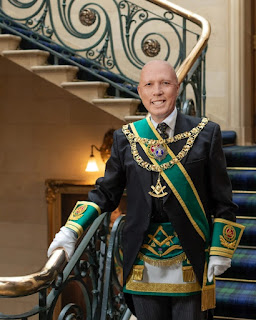Regalia
(pronounced ri-gey-lee-uh or ri-geyl-yuh)
(1) The emblems, symbols, or paraphernalia
indicative of royalty or any other sovereign status; such as a crown, orb,
sceptre or sword.
(2) The decorations, insignia, or ceremonial
clothes of any office or order.
(3) A casual term for fancy, or dressy
clothing; finery.
(4) Royal rights, prerogatives and privileges
actually enjoyed by any sovereign, regardless of his title (emperor, grand duke
etc).
(5) Sumptuous food (obsolete except in the odd literary novel).
(6) A large cigar of the finest quality (obsolete except in the odd literary novel).
1530–1540: From the Medieval Latin rēgālia (royal privileges; things pertaining to a king), noun use of neuter plural of the Latin rēgālis (regal). The word stems from the Latin substantivation of the adjective rēgālis, itself from rex (king). Regalia is a Latin plurale tantum (plural as such, plural only) word that has different definitions. In one ancient (but now rare) definition, it refers to the exclusive privileges of a sovereign, a concept which remains codified in Scots law as Inter regalia (something inherently that belongs to the sovereign) and this may include property, privileges, or prerogatives. The term is a direct borrowing from the Latin inter (among) and regalia (things of the king). In Scots law, the division is between (1) regalia majora (major regalia), which are inseparable from the person of the sovereign and (2) regalia minora (minor regalia), which may be conveyed to a subject. The word originally referred to the formal dress of a sovereign, but is now used of any type of elaborate formal dress or accessories and is applied especially to academic and ecclesiastical robes. Although regalia is a Latin plurale tantum (plural as such, plural only) which, in the grammar of Latin is a noun (in any specific sense) that has no singular form (eg scissors) in most usage, in Modern English, it’s sometimes used in the singular: regale. Further to complicate, the plural form of the grammatical descriptor is pluralia tantum. Regalia is a noun and regalian is an adjective; the noun plural is regalias.
Cardinal George Pell (1941-2023) in ecclesiastical regalia (left) and a deconstruction of the layers (right). The nature of the garments' layers assumed significance in the matter of the cardinal's trial on charges of sexual abuse of a minor, a discussion about the ease and speed with with "accessibility" was physically possible (within the constraints of time and place) being among the evidence offered in defense. Within the Roman Curia (a place of Masonic-like plotting & intrigue and much low skulduggery), Cardinal Pell's nickname was “Pell Pot”, an allusion to Pol Pot (1925–1998, dictator of communist Cambodia 1976-1979) who announced the start of his regime was “Year Zero” and all existing culture and tradition must completely be destroyed and replaced.
Lindsay Lohan being adorned with prom queen regalia (Mean Girls (2004)).
In his original trial the cardinal was convicted, the verdict upheld on appeal to a full bench of the Victorian Court of Appeal. However, upon final appeal to the High Court of Australia (HCA), the conviction was quashed, the judges ruling the Crown had not beyond reasonable doubt proved the acts alleged happened as described, in the circumstances, in the place and at the time mentioned in the indictment. Quash means to nullify, void or declare invalid and is a procedure used in both criminal and civil cases when irregularities or procedural defects are found. In a unanimous (7-0) judgment (Pell v The Queen [2020] HCA 12)) quashing Cardinal Pell’s conviction in the Supreme Court of Victoria (Pell v The Queen [2019] VSCA 186), the High Court set aside the verdict and substituted an acquittal; in a legal sense, it is now as if the original verdict was never handed down.
(1) Enterered Apprentice: The apron of an entered apprentice is plain white to symbolise purity and innocence and usually made of lambs leather.
(2) Fellow Craft: The Fellowcraft apron has the same white background as that of the Enterered Apprentice except for the addition of two blue rosettes. Despite much research and speculation, it’s not known why the color blue is used.
(3) Master Mason: The decoration on a Master Mason’s apron is much more elaborate and is recognizably Masonic in a way the simpler constructions are not. Because many Master Masons elect not to progress to the status of Worshipful Master, for many this will be the apron they wear for their entire Masonic career.
(4) Worshipful Master: The only change to the apron when one enters the chair as Worshipful Master is the blue rosettes are replaced by three levels. The symbols are distinctive so the wearer instantly is recognizable as being a present or past Worshipful Master of a Lodge.
(5) Provincial Honours: Once a mason has gone through the chair and become Worshipful Master, his title changes from Brother to Worshipful Brother. As the years pass, he may be granted Provincial honours and his apron will then be changed from light blue to dark blue with gold braid.


No comments:
Post a Comment